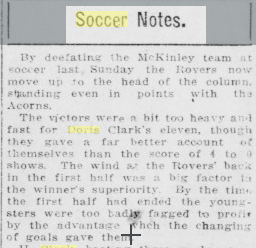Destination Soccer Chattanooga: Part 1 - CFC
Chattanooga has been close to my heart. Growing up in a small town less than an hour south of the city, I spent a lot of time going up to the Scenic City to have anything at all to do. Going to the Tennessee Aquarium (it’s awesome and was at one point the largest freshwater aquarium in the world), the Creative Discovery Museum, the Chickamauga Dam, and the Chattanooga Zoo were all huge part of my childhood.
Despite all of this, I never really knew about Chattanooga FC. I started watching soccer when I was in early middle school. That’s when I picked up my love for Manchester United. A couple of years later, I found out there was a relatively successful team just a few miles from my hometown. I somewhat followed them from then on. I’d check scores and see what was going on, but never really got super into it.
My junior year, I started watching their livestreams and absolutely fell in love with the club. I know I should be a neutral as a journalist, and I do try to be fair to all parties when writing, but, man, do I love the Boys in Blue. The supporters, the atmosphere, the players themselves. It’s all so amazing, and I knew I wanted to write about all of it.
So, I started looking and didn’t really find anywhere that really covered the lower leagues (this was before I fully dove into this wonderful community), so I backed off for a while. I forgot about writing about the lower leagues for a while, but in the summer following my graduation, I revisited the idea. I took to Reddit to see if I could find anywhere to write about this club and Reddit user “stagnation13” told me to reach out to Dan Vaughn because he was starting a lower league project.
I’m so thankful that I did reach out. Being apart of Protagonist has been one of the most impactful things I’ve done in my short and mostly amateur writing career. The people I’ve met and the stories I’ve heard have been incredible.
This series was one I wanted to write from the beginning. I kind of put it off for a while so I could write some other things for the site, but in November of 2018, I went to work. Every day that I was off, I’d drive up to Chattanooga for a couple of interviews I had set up. I talked to Sheldon Grizzle and Tim Kelly of CFC first, then Peter Woolcock of Operation Get Active. The next day off, I spoke with a couple of high school coaches (Baylor’s Curtis Blair and McCallie’s Chris Cushenbery) and former Protagonist writer/CFC Academy coach Justin Haskell. The next day off, I spoke with CFC player Felipe Oliveira, another high school coach (Boyd Buchanan’s Dustin Walker), Lee University Coach Derek Potteiger, and former CFC GM and current Red Wolves GM, Sean McDaniel.
I got to meet people from all parts of the soccer scene that is growing so rapidly in the city. I heard their perspectives on the things happening and see their joy when talking about the clubs they support. These pieces also got me on the other side of the interview for the first time, as the awesome guys that do The 425 Soccer Pod reached out and got me on for an episode.
Looking back, I’m still so proud to have written these pieces. I’m proud that I got to cover this incredible club that calls the best soccer city in the US home. I’m proud that I was able to complete such a large project. Most of all, I’m proud to have written the piece for the best lower league website the internet has to offer.
- Aarik Long
The Destination Soccer Chattanooga Series originally ran the week of June 17, 2019.
Destination Soccer Chattanooga: Part 1 - CFC
2019 will be the eleventh season for the “Chattanooga’s Team,” “The Boys in Blue,” or whatever nickname you want to throw out there for Chattanooga Football Club. When hearing their story, there’s no doubt in your mind that they would have succeeded, but things were not always that simple. The club started in 2008, which was still in the heart of The Great Recession. The economy in the Chattanooga area was as bad as it was anywhere in the nation.
“We would have been happy to have five-hundred people show up,” said team co-founder and president Tim Kelly. That’s all they hoped for. Five-hundred people per game would have been their “wildest dreams” according to the club’s head coach and general manager, Sheldon Grizzle. The first game on May 16th, 2009, against the Atlanta Silverbacks had over 1,600 fans in attendance. Over their first ten years, they have brought nearly 400,000 fans to Finley Stadium, about eight times as many fans as they had originally hoped for.
Volkswagen has been a key sponsor for CFC.
One of the things that the guys at CFC believe helped them out is looking professional from the outset. A beautiful crest, nice kits, playing in a big stadium instead of at a little high school field. It all added up to a professional looking club built by a bunch of volunteers. They even got Volkswagen to sponsor the kits, sort of.
Volkswagen was coming to town to build a massive facility. CFC knew that Volkswagen has a history of supporting soccer, and they’re a fantastic partner anyway. Well, Volkswagen wasn’t going to support a little club just starting out, so CFC got the next best thing, the local VW dealer. “The first year, we just did it. He gave us $500. I don’t know if he ever even wrote the check. We just kind of put it on there,” explains Kelly. They did, however, eventually get the legit sponsorship, which would lead to a partnership with German first division side, VfL Wolfsburg.
Another thing they said had a huge impact was the fact that they weren’t all about soccer. Obviously, they love the game. They started a club after all. But that does not mean everyone else is just as passionate about the game. “If we came out and said ‘Soccer soccer soccer soccer’ then there would have been a lot of yawns. We have more people show up, even to this day, who are more passionate about Chattanooga than they are about soccer,” says Grizzle, “Tapping into that localism spirit is really important.”
“You can’t be about one person trying to make a buck,” adds Kelly, “One of the cancers of US soccer is the idea that you have to have one owner who controls the whole thing and is trying to leverage it into the New York Jets.” The club has spent almost eleven years now putting an emphasis on the community and working to make the club work instead of making a dollar. “We’ve literally reinvested almost every dime back into the club over the years,’ says Grizzle, “I think at most the ownership has taken maybe a couple thousand dollars distribution check. And we even distribute an equal amount to the Foundation. On average, we earn about $200 a year.”
The team has also had a fantastic impact through their work with their foundation and with their academies (I’ll get into some of that in a future installment of this), but they’ve also made waves across the NPSL. A lot of the NPSL’s Southeastern division has Chattanooga’s thumbprint in it. Three teams currently in the division (Inter Nashville FC, Greenville FC, and Asheville City SC) all got help starting up from Chattanooga. Tim Kelly joked that “We made life harder for ourselves. It used to be a lot easier to make it to the National Championship.”
“We will never move the team. We are permanently in Chattanooga.”
Two of the more prominent teams across the NPSL were also impacted by Chattanooga. Sheldon Grizzle told a story of how random chance helped their path cross with the founder of Detroit City FC. “The founders of Detroit City FC was in Chattanooga having beers with me and a couple of friends right across the street over here. I started telling him about what we’re doing with Chattanooga FC and they were looking at each other like ‘We’re doing this in Detroit.’” Grizzle also said that they helped out with the Kingston Stockade. “We became friends with Dennis Crowley of the Kingston Stockade. Helped him through the whole process of figuring out how to get a team off the ground. And not only how we do it, but why we do it. He was able to bring that into a new community.”
The club has done something that so many other clubs have failed to do. They connected with the community to find long-term success. “Authentic grassroots thing. By Chattanoogans for Chattanoogans. It is authentically Chatanoogan. We were able to create that at a time when there wasn’t a whole lot to root for.” What they’ve done here has been insanely impactful and has really set off a chain reaction throughout the city’s soccer scene. In the next few installments, we’ll dig into those. From the CFC Academy and their foundation to the local high school and college soccer programs all the way to the Red Wolves coming to down. “The Club that Chattanooga Built” had an impact on it all.
- Aarik Long
























